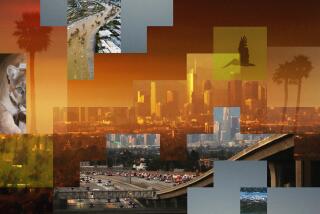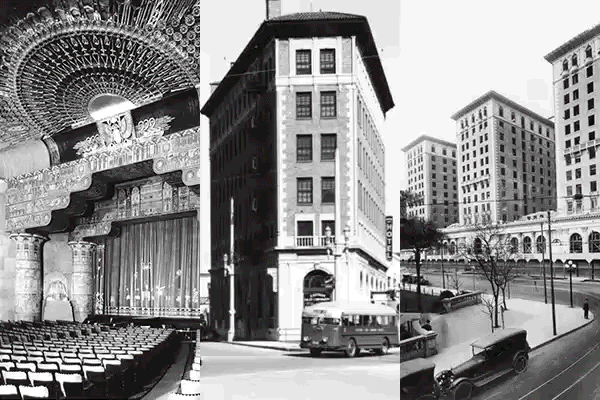Old Trolleys Will Clang Again
- Share via
“Novel Sights Each Mile and Each Turn of the Road!” boasted the rapid transit ads of a half-century ago, almost as though traveling on the streets of Los Angeles could be . . . well, fun.
Back then, no one used the stuffy, technical term “light rail” for the electric vehicles that jolted and rocked along tracks on runs like the Venice Short Line. They were trolleys.
“I remember coming over the North Broadway bridge and how you would see a panorama of snow-capped mountains in the winter,” said Ray Younghans, who commuted downtown from the Glassell Park area in the 1940s and 1950s aboard a Yellow Car. “It was just a beautiful ride.”
It’s been a quarter-century since the last clang-clang-clang of a trolley in Los Angeles. The Yellow Car--the city’s local line--made its final run on March 31, 1963, two years after the more far-flung Red Cars disappeared.
To commemorate the death of the Yellow Car, the Orange Empire Railway Museum in Perris is holding a memorial streetcar service ceremony at 2 p.m. today.
The museum, located about 17 miles south of Riverside, derives its name from an old trolley tour of Riverside County, which was called, in the grandiose ad language of the time, “the Kingdom of the Orange.”
The anniversary ceremony will feature a parade of functional trolleys along the museum’s transplanted 2-mile track, including a Yellow Car that squashed at least one Laurel and Hardy Model-T. There’s also a Red Car on which Gene Kelly danced in “Singin’ in the Rain” before he jumped into a car driven by Debbie Reynolds--a kind of symbolic moment in the history of the trolley.
Only a few of the 1,800 Yellow and Red cars that operated in the 1920s remain from that golden age of trolleydom. Most went for scrap, some are anchored off the coast as havens for fish, and others were sold to Korea, Egypt and South America.
“I even saw photos of one that was converted into a home after World War II,” said Paul Hammond, one of the museum’s directors. “Housing was scarce then and people would buy the (trolley) bodies from scrap dealers and decorate them.”
In a time of car-choked freeways, when a new Long Beach-to- Los Angeles light-rail route is planned along a former Red Car line, the mystique of the old trolleys remains.
A few months ago, the television show “60 Minutes” revived a charge that Los Angeles’ trolleys were the victims of a conspiracy involving General Motors, the Firestone Tire and Rubber Co. and others.
Visiting the Orange Groves of the Great San Gabriel Valley . . . the World’s renowned Cawston Ostrich Farm . . . Skirting the Foothills of the Great Sierra Madre Mountains . . . Famous Old Mission San Gabriel and Other Interesting Places
--An early trolley ad
The Red and Yellow cars owed their growth to a frustrated nephew.
Henry Huntington had tried and failed to gain control of the Southern Pacific Railroad in 1900 upon the death of his uncle, Collis Huntington. So he founded the Pacific Electric Railway Co. the next year.
(Henry Huntington was determined to follow in his uncle’s footsteps in more than one way. He also divorced his wife and married his uncle’s widow, Arabella.)
Huntington extended his electric-car lines in several directions, north to the San Fernando Valley, east to San Bernardino, south to Newport Beach, speeding the growth of the suburbs.
The early Red Cars and yellow trolleys were far from lavish. They offered hard benches for seats and were built “California-style,” meaning that they had a low screen instead of doors, and open window spaces in the front and back.
“If it started to rain, they would pull a shade down,” said Jim Walker, author of “The Yellow Cars of Los Angeles.” “They figured if it rained not many people would ride and those that did would huddle in the middle. The poor driver, though, he could get pretty cold.”
A trip without a rival, through the heart of Orange County . . . the great Sugar Beet and Celery fields . . . Santa Ana, city of beautiful homes . . . the New Delhi Sugar Factory . . . Long Beach the beautiful. . . .
A decade after he came on the scene, Huntington sold his Pacific Electric line (the Red Cars) to Southern Pacific but kept the Los Angeles Railway (the Yellow Cars).
The early popularity of the trolleys in some ways foreshadowed their doom. Residents drawn to the outlying areas by the electric cars were finding freedom in a new form of transportation: the automobile.
The climate and the geography accommodated them. Southern California offered mostly sunshine and flat surfaces. The rivalry between trolley and automobile was sometimes played out at intersections where they collided.
Other factors contributed to the death of the trolleys, too: the preference of the downtown business community for expanded automobile routes as opposed to rapid transit, the public’s unwillingness to pay for rapid transit, and the failure of the trolley companies to upgrade their own carriers.
World famous Mt. Lowe -- A climb from Sea Level to Cloud and by Trolley through America’s Greatest Scenic Wonderland.
In the mid-1940s, the estate of Henry Huntington sold Los Angeles Railway to National City Lines, a Chicago-based company. The new owners began to substitute buses for trolleys, a process that would be duplicated in more than 40 other cities.
General Motors made the buses and Firestone supplied the tires. General Motors and Firestone were also part owners of National. In 1946, a federal grand jury indicted National, General Motors, Firestone and several other companies on antitrust charges. The case involved alleged preferential treatment given to firms such as General Motors The defendants were found guilty, and National voided all future contracts with the other companies. The fine for each defendant was $5,000.
However, the larger question--whether General Motors and the others plotted to dismantle the trolley systems--never reached the courts.
The defendants always maintained that since both trolley systems were reporting losses, they were just following sound business principles.
Tracks were quickly ripped up, and the trolley companies often lost or sold their rights-of-way, making a future return to rapid transit improbable in many areas.
You can’t afford an auto for your daily trip to town.
Trolley fan Ray Younghans of Los Angeles, who keeps a partially restored Yellow Car in his back yard, isn’t sure he’ll be able to attend the Perris ceremony.
“I’ve got to get a ride,” said Younghans, who never learned to drive.
More to Read
Sign up for Essential California
The most important California stories and recommendations in your inbox every morning.
You may occasionally receive promotional content from the Los Angeles Times.










